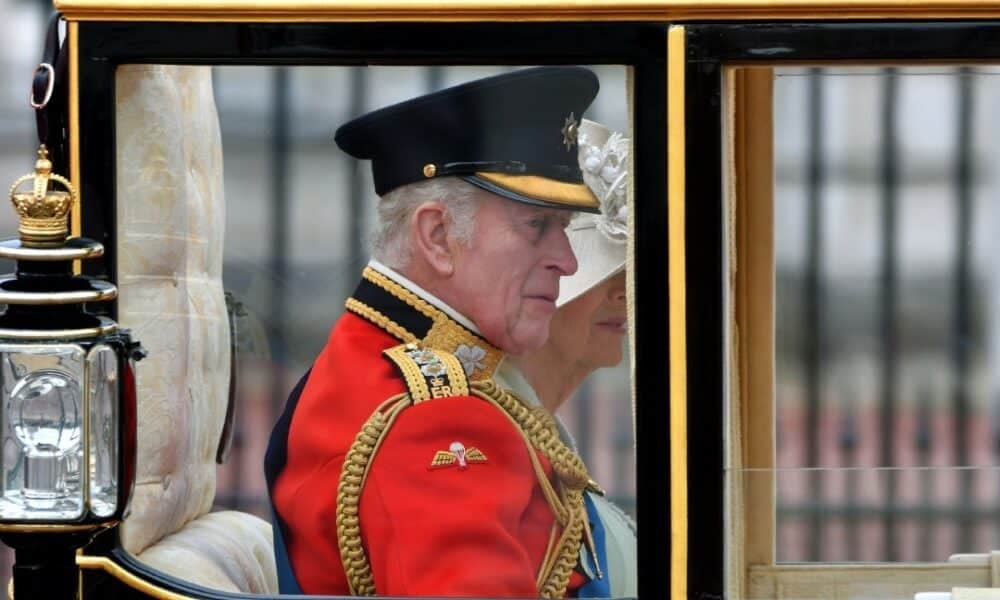At 76, King Charles III faced a brief hospitalization on March 27, 2025, due to side effects from his ongoing cancer treatment, a condition diagnosed in February 2024. The monarch, who ascended the throne in September 2022 following the death of his mother, Queen Elizabeth II, underwent a procedure for a benign prostate enlargement early last year, which led to the discovery of the disease. Since then, he has followed a regular treatment schedule, but this recent event, requiring observation at The London Clinic, raised concerns about his health and reignited discussions about the British monarchy’s succession. Amid this, Prince William and Kate Middleton, the Prince and Princess of Wales, emerge as key figures in preparing for the throne’s future.
Although Buckingham Palace has not disclosed the cancer’s type or stage, Charles returned to Clarence House after being discharged on the same day, canceling engagements set for March 28 in Birmingham. This temporary pause in public appearances shifts attention to William, 42, first in line to the throne, and Kate, who faced her own cancer diagnosis in 2024 but announced remission in September. Parents to George, Charlotte, and Louis, the couple navigates family life and royal duties during a challenging time for the Crown.
Observers note that Charles III’s health, combined with Kate’s recovery, places William under growing pressure to take on a more prominent role. While the king manages his condition, described as “under control” by close sources, William has stepped up, representing his father at events like the Notre-Dame Cathedral reopening in Paris in December 2024. This situation underscores the gradual transition unfolding within the monarchy, with William and Kate poised to lead sooner than anticipated.
Early focus on succession
Charles III’s diagnosis has spotlighted the British line of succession. William, as the direct heir, is followed by his children: George, 11, Charlotte, 9, and Louis, 6. Governed by descent and parliamentary statute, the monarchy excludes Queen Camilla from the succession, keeping the focus on Charles’s direct descendants.
- Prince William: First in line, set to become king if Charles abdicates or passes away.
- Prince George: Second in line, the future heir after his father.
- Princess Charlotte: Third in line, followed by her brother Louis.

Charles III’s journey and cancer challenges
Diagnosed in February 2024, Charles III began a treatment regimen that, according to those close to him, shows positive progress, though no end date has been set. His March 27 hospitalization stemmed from temporary side effects of a treatment administered that morning. Having paused therapy in October 2024 for an official trip to Australia and Samoa, the king demonstrates resilience, yet adjustments to his schedule signal medical caution.
Before taking the throne, Charles spent decades as Prince of Wales, the longest-serving heir in British history. His coronation in May 2023 launched a reign now tested by unforeseen health issues. An initial two-month break from public duties followed his diagnosis, but by May 2024, he resumed activities, including the 80th D-Day anniversary in Normandy. The recent hospitalization, however, renews concerns about his ability to maintain a full agenda.
Kate Middleton’s own cancer journey began after abdominal surgery in January 2024. Months of preventive chemotherapy followed, culminating in remission by September. Her gradual return to public life, marked by a visit to the Royal Marsden Hospital in January 2025, showcased her empathy with patients, strengthening her role alongside William amid the family’s dual health crises.
William and Kate in the royal spotlight
Prince William has emerged as a cornerstone of the monarchy during these health challenges. At 42, he balances additional duties with supporting Kate and their children. In November 2024, while attending the Earthshot Prize in South Africa, he called the year “brutal,” reflecting the toll of his father’s and wife’s illnesses.
Now in remission, Kate has resumed a limited schedule of public engagements. Her visit to the Royal Marsden Hospital, where she received care, marked a turning point, reinforcing her image as a future queen consort. Having completed chemotherapy in September 2024, she plans to expand her activities throughout the year, supporting William in preparing for their eventual reign.
The couple’s partnership is a strength for the monarchy. As Charles manages his condition, William and Kate are seen as ready to modernize the institution, blending tradition with contemporary challenges. William’s environmental advocacy, inherited from his father, and Kate’s focus on early childhood development highlight their priorities as future leaders.
Timeline of Charles III’s health events
Charles III’s health developments follow a timeline of significant moments, reflecting the treatment’s progression and its impact on his duties.
- February 2024: Cancer diagnosed after prostate procedure.
- May 2024: Public duties resume after initial break.
- October 2024: Treatment paused for Australia and Samoa trip.
- March 27, 2025: Brief hospitalization for side effects, discharged same day.
This timeline reveals efforts to balance health and royal responsibilities, though the Birmingham cancellation suggests ongoing adjustments.
Pressures on the future king
William faces a unique scenario: supporting his father, raising a family, and preparing for the throne. His 2024 engagements, like meeting U.S. President-elect Donald Trump in December and environmental events in Africa, showcase his leadership. With Prince Harry, fifth in line, distanced from royal duties, William and Kate bear heightened responsibility.
Kate benefits from support by Princess Anne and Sophie, Duchess of Edinburgh, as she transitions to her future role. Her resilience post-cancer earns praise, and her return to public life bolsters confidence in the monarchy’s continuity under her and William’s leadership.
Charles’s vision of a “slimmed-down” monarchy, with fewer active members, now hinges on William and Kate. The king’s illness and Kate’s recovery test this model, yet highlight the couple’s readiness to step up during a pivotal time.
Resilience of the royal family in tough times
The British royal family has weathered health crises before, but the simultaneous impact on Charles and Kate is unprecedented. While the king handles behind-the-scenes tasks, like meetings with the prime minister, William takes the lead in public. Kate’s recovery adds empathy and relatability to their efforts.
Queen Camilla has been a steady presence for Charles, joining him when possible and stepping out solo, as in a March 2025 TV set visit. Harry’s absence, following his 2020 exit, underscores ongoing family tensions, leaving William and Kate as the primary support.
The couple’s strength, with their children George, Charlotte, and Louis as the next generation, anchors the monarchy. They carry the immediate burden of sustaining the institution through uncertainty.
Tips to grasp the British succession
Understanding the succession and William and Kate’s roles requires attention to historical and current details. Key points clarify the situation.
- Succession follows direct descent and parliamentary laws.
- William will reign as William V, per historical numbering.
- Kate will be Queen Consort, not Queen Regnant.
Impacts on Charles III’s reign
Charles III’s cancer has reshaped his reign, begun less than two years ago. His plans to modernize the monarchy, emphasizing causes like the environment, faced delays due to his condition. The Australia trip, though successful, required a treatment break, highlighting physical limits.
The king trusts William and Kate to carry forward his legacy. Conversations with courtiers suggest he believes the monarchy “will be in good hands” with them, praising Kate’s competence and William’s lifelong preparation.
The recent hospitalization, though short, underscores vulnerability. With treatment ongoing into 2025, a transition to William may accelerate—whether by abdication or necessity—ensuring the Crown’s stability in a critical period.

At 76, King Charles III faced a brief hospitalization on March 27, 2025, due to side effects from his ongoing cancer treatment, a condition diagnosed in February 2024. The monarch, who ascended the throne in September 2022 following the death of his mother, Queen Elizabeth II, underwent a procedure for a benign prostate enlargement early last year, which led to the discovery of the disease. Since then, he has followed a regular treatment schedule, but this recent event, requiring observation at The London Clinic, raised concerns about his health and reignited discussions about the British monarchy’s succession. Amid this, Prince William and Kate Middleton, the Prince and Princess of Wales, emerge as key figures in preparing for the throne’s future.
Although Buckingham Palace has not disclosed the cancer’s type or stage, Charles returned to Clarence House after being discharged on the same day, canceling engagements set for March 28 in Birmingham. This temporary pause in public appearances shifts attention to William, 42, first in line to the throne, and Kate, who faced her own cancer diagnosis in 2024 but announced remission in September. Parents to George, Charlotte, and Louis, the couple navigates family life and royal duties during a challenging time for the Crown.
Observers note that Charles III’s health, combined with Kate’s recovery, places William under growing pressure to take on a more prominent role. While the king manages his condition, described as “under control” by close sources, William has stepped up, representing his father at events like the Notre-Dame Cathedral reopening in Paris in December 2024. This situation underscores the gradual transition unfolding within the monarchy, with William and Kate poised to lead sooner than anticipated.
Early focus on succession
Charles III’s diagnosis has spotlighted the British line of succession. William, as the direct heir, is followed by his children: George, 11, Charlotte, 9, and Louis, 6. Governed by descent and parliamentary statute, the monarchy excludes Queen Camilla from the succession, keeping the focus on Charles’s direct descendants.
- Prince William: First in line, set to become king if Charles abdicates or passes away.
- Prince George: Second in line, the future heir after his father.
- Princess Charlotte: Third in line, followed by her brother Louis.

Charles III’s journey and cancer challenges
Diagnosed in February 2024, Charles III began a treatment regimen that, according to those close to him, shows positive progress, though no end date has been set. His March 27 hospitalization stemmed from temporary side effects of a treatment administered that morning. Having paused therapy in October 2024 for an official trip to Australia and Samoa, the king demonstrates resilience, yet adjustments to his schedule signal medical caution.
Before taking the throne, Charles spent decades as Prince of Wales, the longest-serving heir in British history. His coronation in May 2023 launched a reign now tested by unforeseen health issues. An initial two-month break from public duties followed his diagnosis, but by May 2024, he resumed activities, including the 80th D-Day anniversary in Normandy. The recent hospitalization, however, renews concerns about his ability to maintain a full agenda.
Kate Middleton’s own cancer journey began after abdominal surgery in January 2024. Months of preventive chemotherapy followed, culminating in remission by September. Her gradual return to public life, marked by a visit to the Royal Marsden Hospital in January 2025, showcased her empathy with patients, strengthening her role alongside William amid the family’s dual health crises.
William and Kate in the royal spotlight
Prince William has emerged as a cornerstone of the monarchy during these health challenges. At 42, he balances additional duties with supporting Kate and their children. In November 2024, while attending the Earthshot Prize in South Africa, he called the year “brutal,” reflecting the toll of his father’s and wife’s illnesses.
Now in remission, Kate has resumed a limited schedule of public engagements. Her visit to the Royal Marsden Hospital, where she received care, marked a turning point, reinforcing her image as a future queen consort. Having completed chemotherapy in September 2024, she plans to expand her activities throughout the year, supporting William in preparing for their eventual reign.
The couple’s partnership is a strength for the monarchy. As Charles manages his condition, William and Kate are seen as ready to modernize the institution, blending tradition with contemporary challenges. William’s environmental advocacy, inherited from his father, and Kate’s focus on early childhood development highlight their priorities as future leaders.
Timeline of Charles III’s health events
Charles III’s health developments follow a timeline of significant moments, reflecting the treatment’s progression and its impact on his duties.
- February 2024: Cancer diagnosed after prostate procedure.
- May 2024: Public duties resume after initial break.
- October 2024: Treatment paused for Australia and Samoa trip.
- March 27, 2025: Brief hospitalization for side effects, discharged same day.
This timeline reveals efforts to balance health and royal responsibilities, though the Birmingham cancellation suggests ongoing adjustments.
Pressures on the future king
William faces a unique scenario: supporting his father, raising a family, and preparing for the throne. His 2024 engagements, like meeting U.S. President-elect Donald Trump in December and environmental events in Africa, showcase his leadership. With Prince Harry, fifth in line, distanced from royal duties, William and Kate bear heightened responsibility.
Kate benefits from support by Princess Anne and Sophie, Duchess of Edinburgh, as she transitions to her future role. Her resilience post-cancer earns praise, and her return to public life bolsters confidence in the monarchy’s continuity under her and William’s leadership.
Charles’s vision of a “slimmed-down” monarchy, with fewer active members, now hinges on William and Kate. The king’s illness and Kate’s recovery test this model, yet highlight the couple’s readiness to step up during a pivotal time.
Resilience of the royal family in tough times
The British royal family has weathered health crises before, but the simultaneous impact on Charles and Kate is unprecedented. While the king handles behind-the-scenes tasks, like meetings with the prime minister, William takes the lead in public. Kate’s recovery adds empathy and relatability to their efforts.
Queen Camilla has been a steady presence for Charles, joining him when possible and stepping out solo, as in a March 2025 TV set visit. Harry’s absence, following his 2020 exit, underscores ongoing family tensions, leaving William and Kate as the primary support.
The couple’s strength, with their children George, Charlotte, and Louis as the next generation, anchors the monarchy. They carry the immediate burden of sustaining the institution through uncertainty.
Tips to grasp the British succession
Understanding the succession and William and Kate’s roles requires attention to historical and current details. Key points clarify the situation.
- Succession follows direct descent and parliamentary laws.
- William will reign as William V, per historical numbering.
- Kate will be Queen Consort, not Queen Regnant.
Impacts on Charles III’s reign
Charles III’s cancer has reshaped his reign, begun less than two years ago. His plans to modernize the monarchy, emphasizing causes like the environment, faced delays due to his condition. The Australia trip, though successful, required a treatment break, highlighting physical limits.
The king trusts William and Kate to carry forward his legacy. Conversations with courtiers suggest he believes the monarchy “will be in good hands” with them, praising Kate’s competence and William’s lifelong preparation.
The recent hospitalization, though short, underscores vulnerability. With treatment ongoing into 2025, a transition to William may accelerate—whether by abdication or necessity—ensuring the Crown’s stability in a critical period.







